A week later than I had thought, though I noticed no one was beating my email doors down to get to the second part of the WIP on my Pastel painting.
Before we get in to the final part of the demo, I would like to point out that this painting is currently hanging through the end of March at Paxton's Bar & Grill in Loveland, OH. And, yes, it is for sale!
Getting back to the Pastel Demonstration. As I mentioned in the previous entry, it's really important to keep you hands and fingers as clean as possible. It really helps to have a damp towel and/or some hand wipes nearby. Beginning with Stage Seven, there is very little finger blending. In fact, I purposely avoid finger blending in order to allow the pastel sticks themselves to begin the blending process.
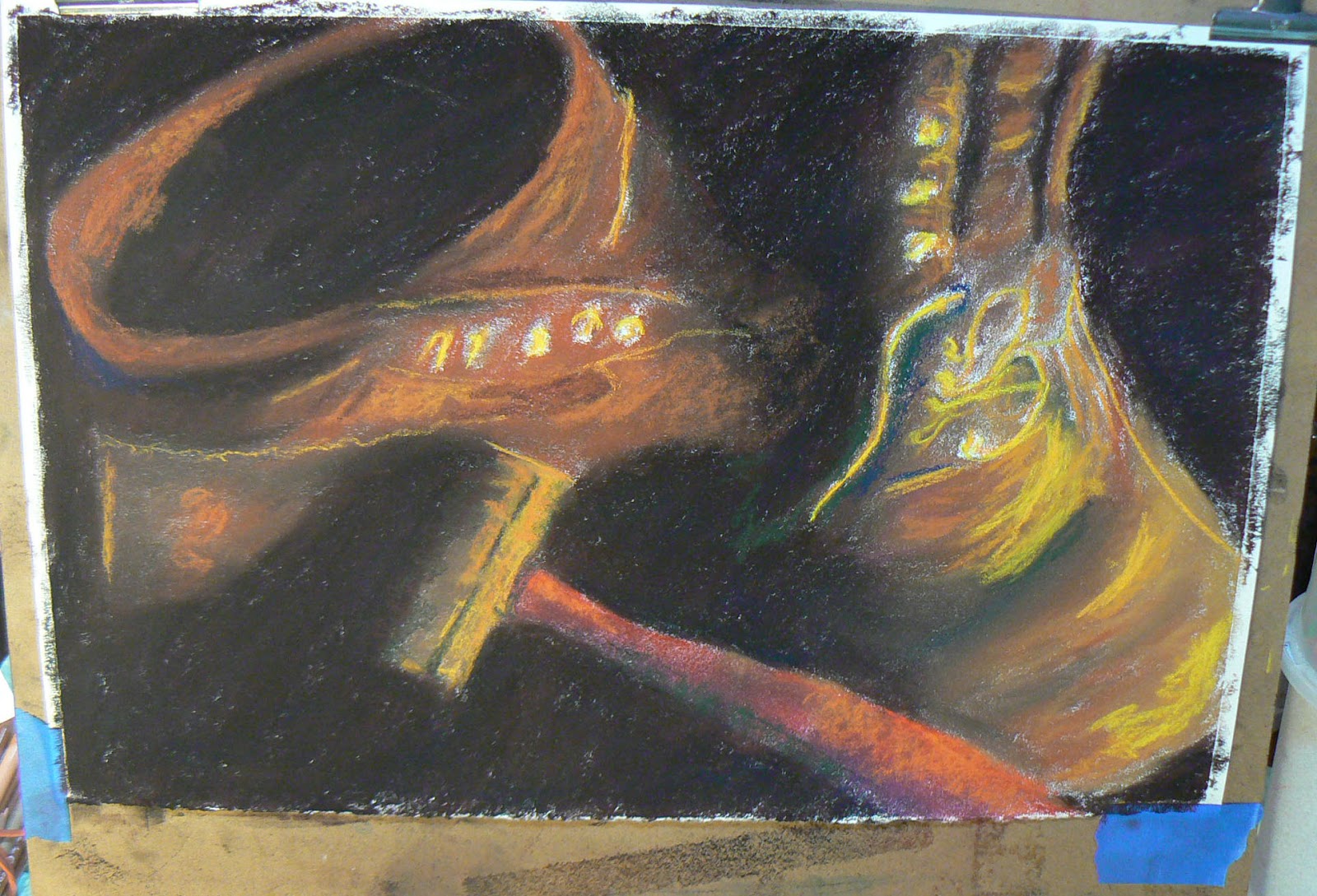 |
| Stage Seven |
|
At this point, you begin moving away from NuPastels, which are harder, and begin moving toward your softer pastels.
The mid-range softness in pastels, for me at least, are the Rembrandt brand. You can generally find them in open stock as well as in half-stick sets.
In Stage Seven, I began applying the Rembrandts -- yellows and oranges, and you might even detect there is some green in the shadow areas. I was hoping to give the shoes, and the background as well, a little more contrast or depth. I applied orange along the handle of the hammer and again, on the side of the left boot.
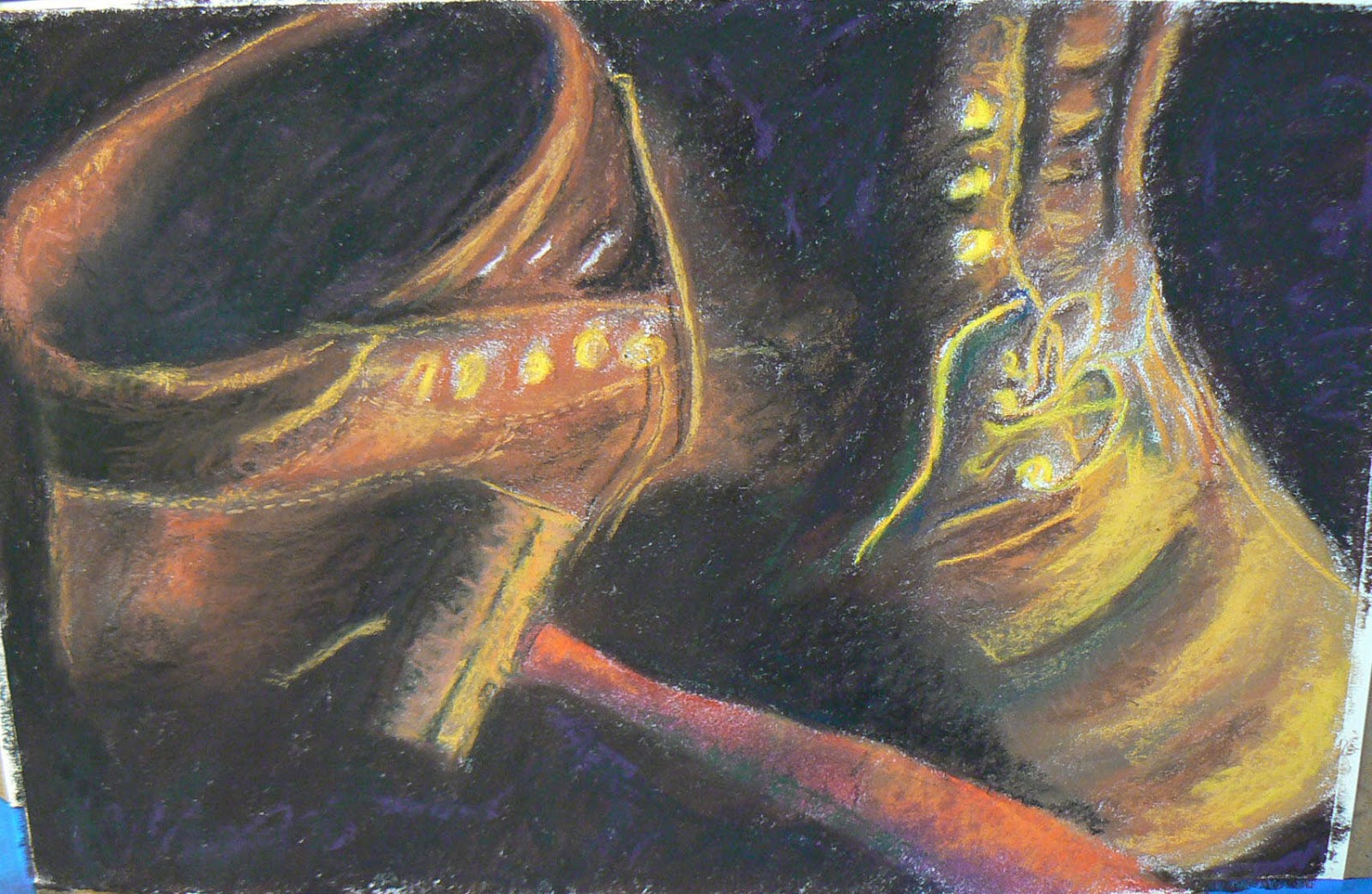 |
| Stage Eight |
Just as I said I try to avoid finger blending, I realized that I wasn't completely satisfied with the depth of the background, so I added some softer purple in various places. I knew when I added it that I was going to have to blend it. But that is part of the process of your work. You have to push and pull, add-subtract to get to where you want your work to go.
You might also note that I have begun blending the reflection on the right shoe as well. That was done with the pastels. At this stage, I was moving back and forth between the Rembrandts, and the two softer brands that I prefer using -- Unison and Great American Pastels.
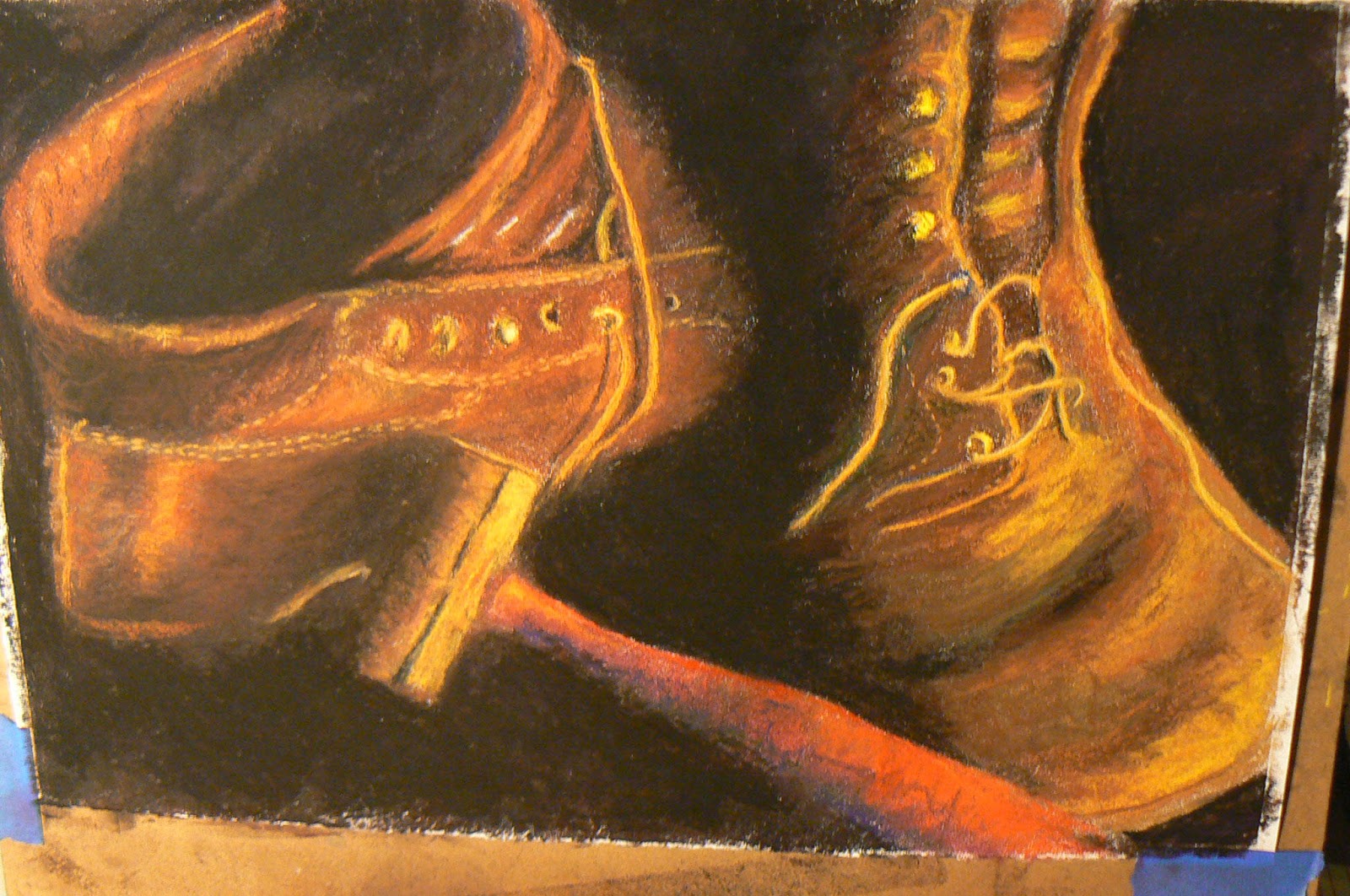 |
| Stage Nine |
I toned down the colors. The previous layering was done intentionally to make sure the highlights were where I wanted them. I also knew that they were too harsh. The other thing that was bugging me was the way the shoe string draped the right boot. It made it too complicated originally. Keep it simple. So I eliminated part of the lacing. I also started work on more details, such as the eyelets.
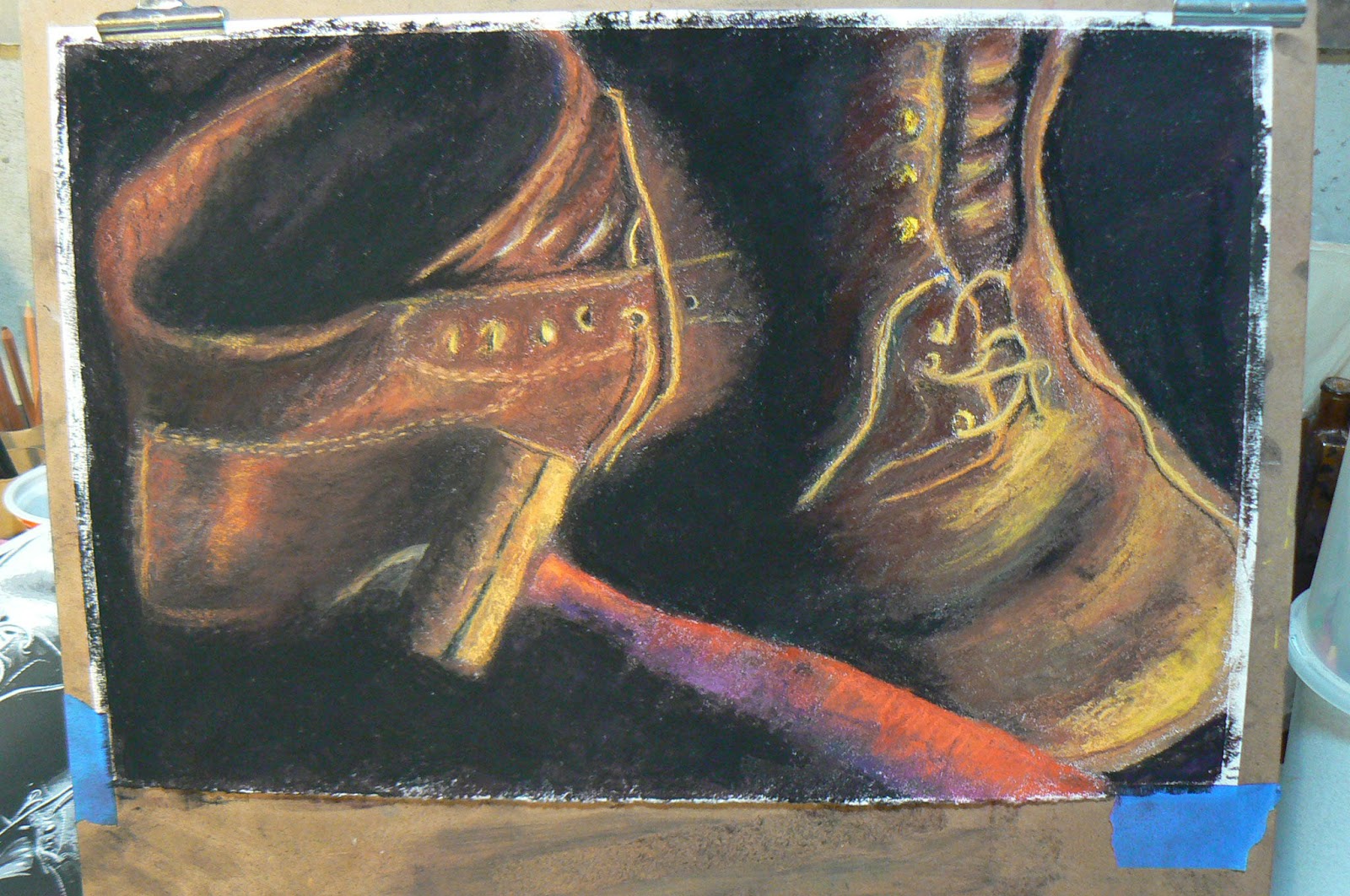 |
| Stage Ten |
Again, more detail work with various sticks. On some of the finer detail work, I went back to the NuPastels because I could get a finer point on the end of the stick. I also sprayed the painting at this point with a fixative. I used Latour fixative by Sennalier. I made a couple passes over the paper from about three feet away.
There are various schools of thought on using fixatives with pastel work. Many pastels artists do not like to use fixatives because they believe it has a negative impact on the vibrancy of the colors. In my case, I actually wanted to tone down the colors in addition to sealing the pastels to the surface.
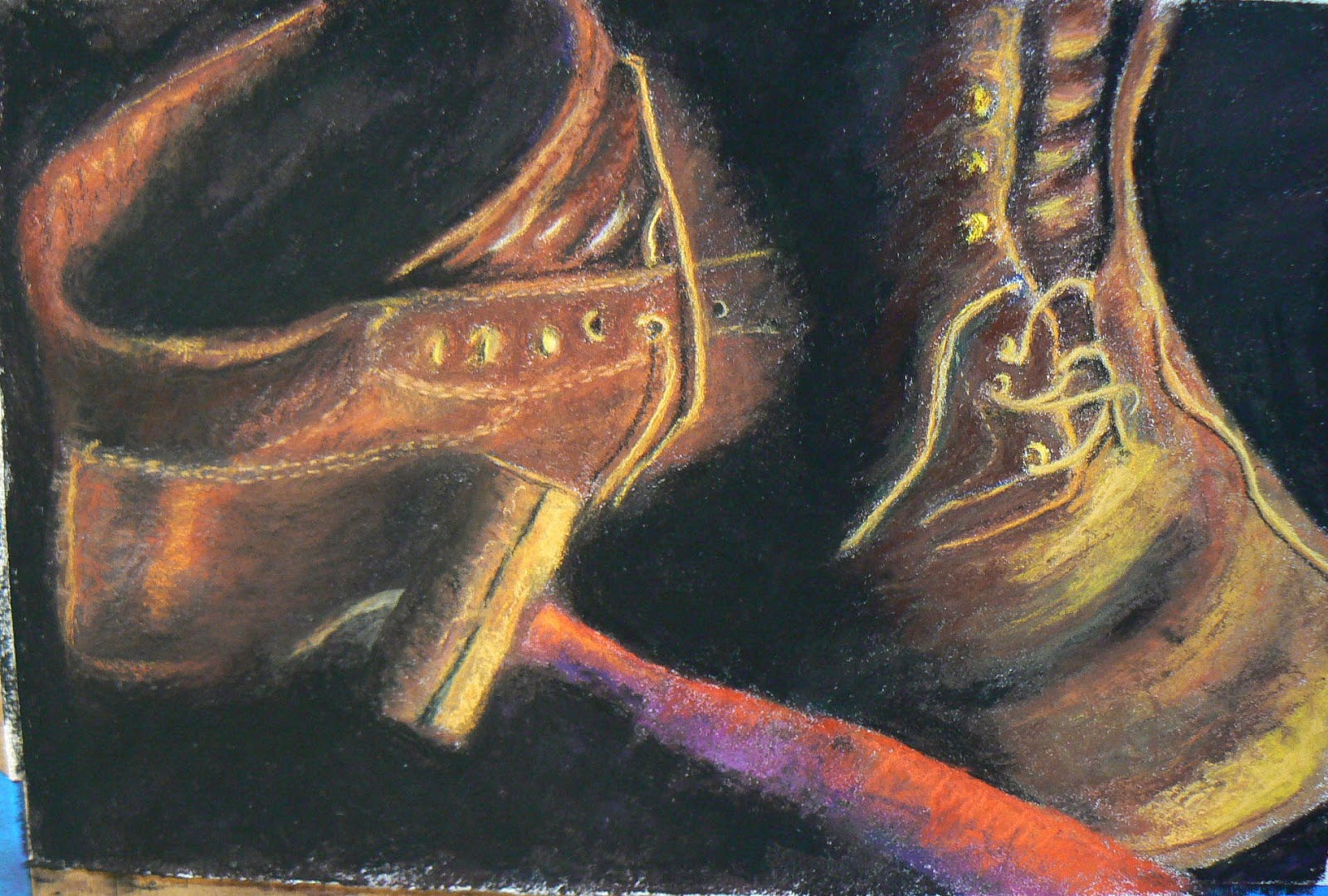 |
| Stage Eleven |
Now I am really working more on details and fixing things that I feel needed work. I still wasn't completely satisfied with the crack in the head of the hammer. Nor did I feel the hammer showing the contour and shape of the handle. I also touched up the leather again to make sure it was dark where I wanted it (on the right shoe) and more glowing on the left shoe.
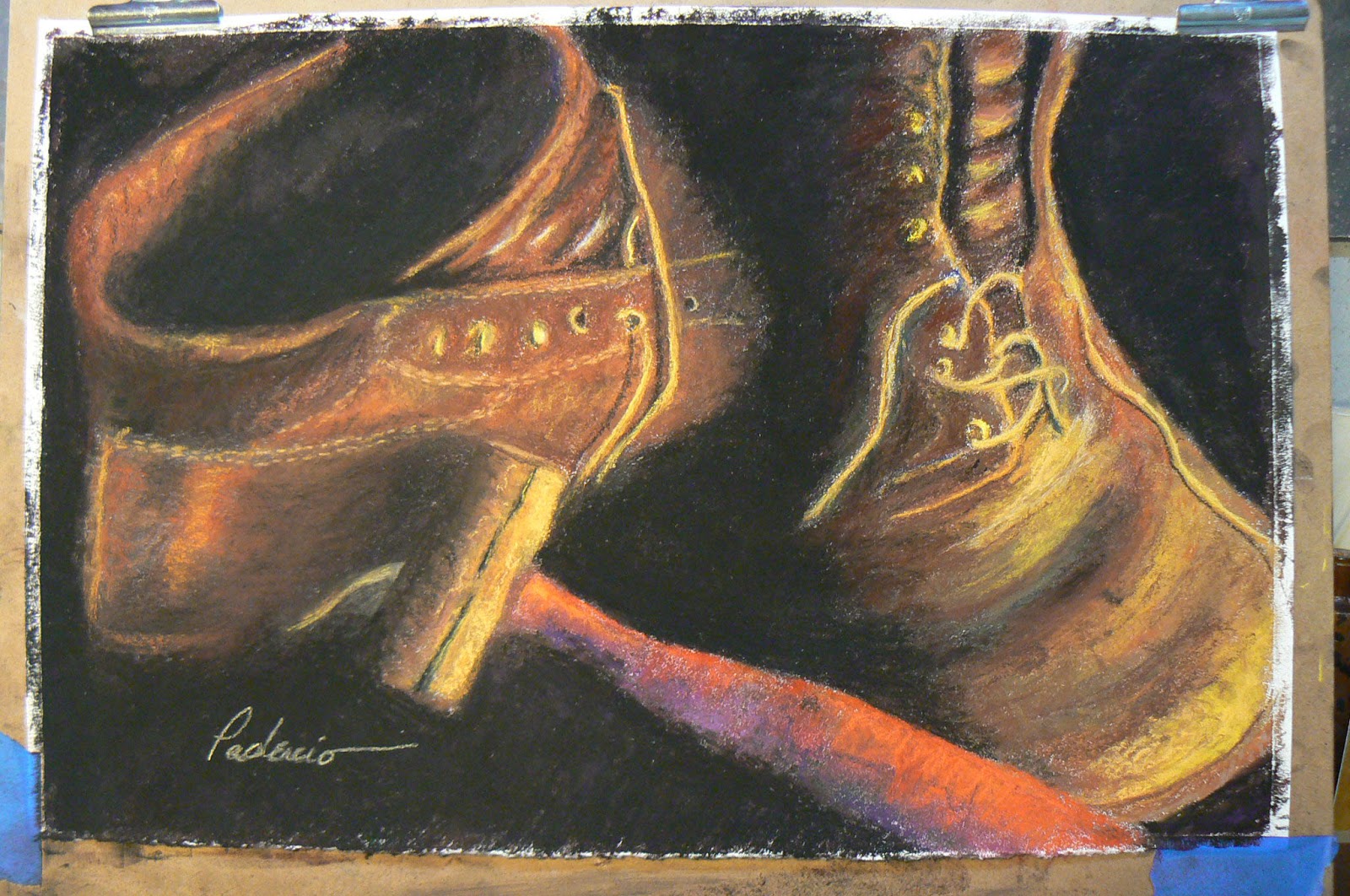 |
| Fini! |
With the softest pastels I have, the Great American brand, I began tapping on the surface of the paper where I wanted highlights. Using the same pastels, I dragged them across the surface very lightly to add some last minute color.
When I was finally satisfied with the product, I applied my signature.
The final step in the process is to get a sheet of glassine paper. It looks a lot like wax paper only without the heavy wax side. I placed the glassine paper over the top of the painting, then I got a soft-rubber brayer and, applying solid pressure, rolled the brayer over the top of the glassine paper. This pressure helps adhere the pastel to the surface and helps prevent on dust falling off the painting after you get it framed.
I know I should have taken a photograph of the painting in the frame. If the painting doesn't sell, then I will make sure I get that done and will post it on the blog.
When you are framing a pastel painting, you should always make sure you use spacers between the painting and the mat. The mat board itself should be reverse-beveled. You do both of those things to allow pastel dust to drop down behind the mat and not inside the glass atop the mat board. You don't want to see pastel dust collecting at the bottom of your framed artwork.
I certainly don't think this is the definitive process in pastel painting and I am far from an expert. The purpose of his demo-WIP was to show how I did this particular painting, what steps were involved and what I was thinking as the process was going along.
I certainly hope this is helpful to those who might be reading this and are wondering about working in pastels. There are many excellent books on the subject. The book many acknowledge as "the Bible" on pastel painting, however, is The Pastel Book by Bill Creevy.
Hopefully, I will be able to maintain the promised weekly schedule on my art blog. Next week, I will feature one of my favorite colored pencil artists in John Smolko.
Till, then -- Keep Arting!
I hope that everyone had a safe and happy time with their family and friends during the holidays!
The original plan was to get this blog up and running on a weekly basis after the first of the year. I started early mainly because I wanted to see if I could get it to work and look the way I wanted. So far so good.
So on to the plan ...
This week and next week I will feature what artists call WIP or Work In Progress. As an artist I find WIPs to be beneficial for a number of reasons. First, it's interesting to see how an artist approaches their subject. Second, I enjoy seeing how the piece of work goes from one stage to the next. Third, if there's explanation on how Step One moved on to Step Two, then it becomes educational. And, really, that's the most important thing for me as an artist. How did they do that? What were they thinking when they did that? Why did they do that then?
When I assembled the photos for this week's session, I realized I had 13 photos. Not sure if that many will be helpful at all or if it will be overkill. Based upon your reaction, I will use the same or less the next time I do this. (That's assuming, of course, anyone is actually reading this! LOL)
This WIP will be a pastel painting that i recently finished called "These Boots Are Made for Working." The setup includes a small tabletop desk easel and the surface taped at the bottom and clipped at the top to a piece of masonite board. On the table underneath the easel, I have a disposable underpad that can be purchased at medical supply stores or a pharmacy. On top of that, right beneath the easel, I have a metal tray, not unlike a cookie tray. I have that "lined" with a couple paper towels. The tray catches the pastel dust that falls down from the painting and it also is a handy spot to put my pastels on as I use them. That way I can keep track of what colors I'm using.
For the most part, I used Prismacolor NuPastel pastel sticks, Rembrandt pastel sticks, Unison Pastels and Great American Pastels -- which are, incidentally, made right here in Cincinnati.
So, on with the show ...
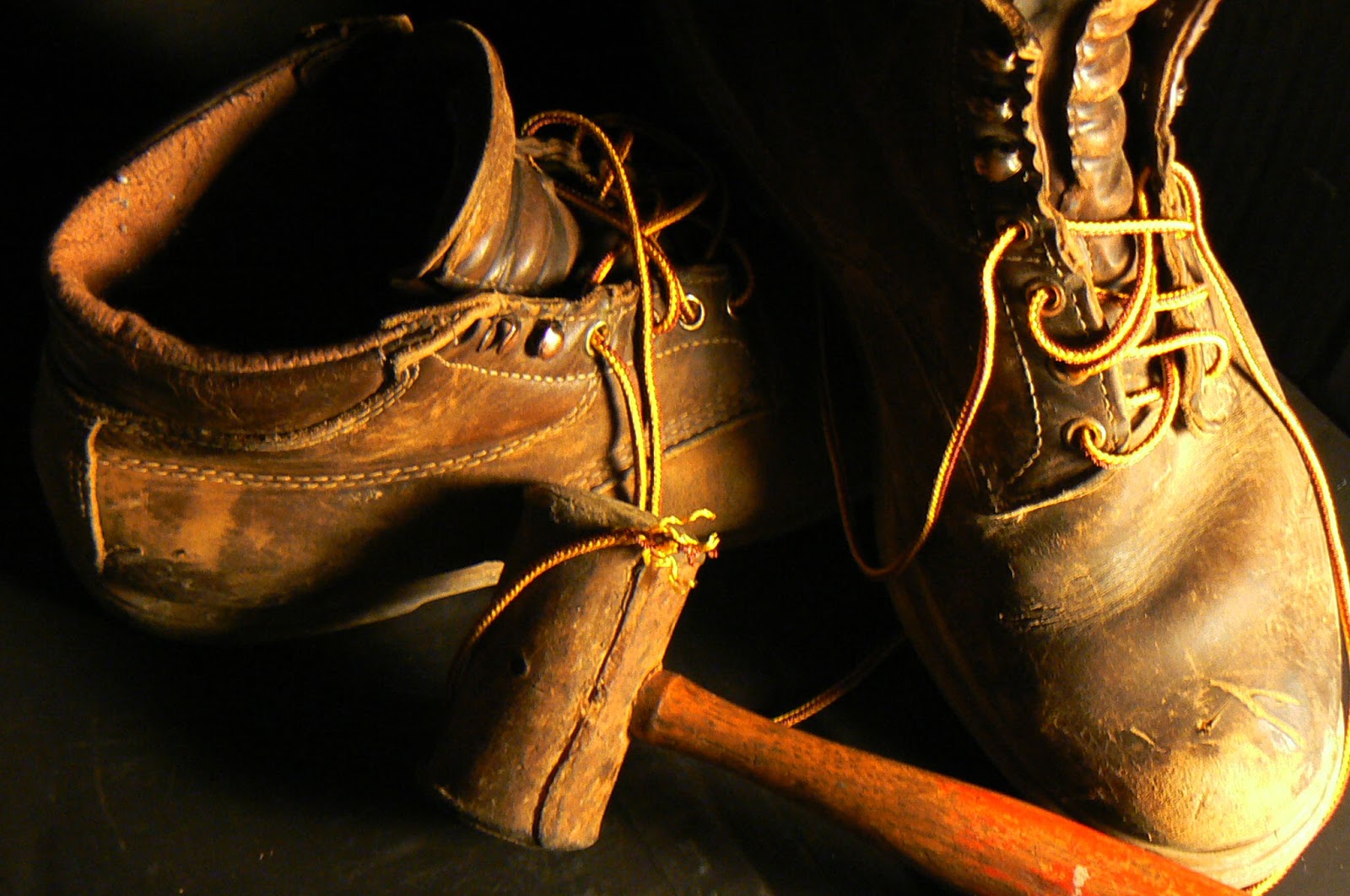 |
| Original photo |
The photo at the right is the original still life that I set up using a pair of old boots. The wooden hammer belonged to my father and somehow ended up my toolbox that I rarely use. The boots are made by Red Wing Shoes, a company based in Red Wing, MN that still manufactures many of their shoes in the United States.
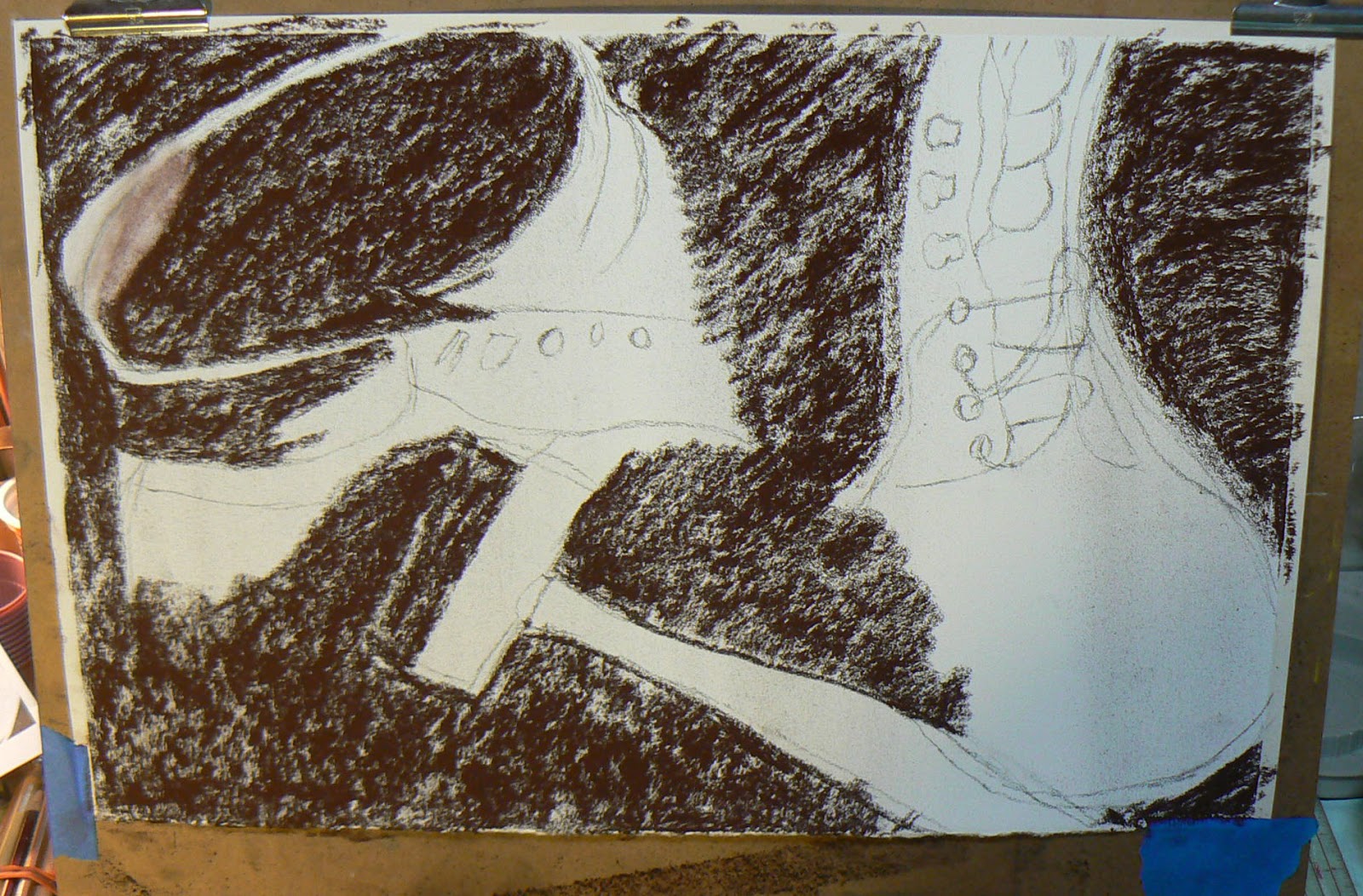 |
| Step One |
I enjoyed the pastel technique that I learned this past November and wanted to continue to pursue it. The "Still Life With Pear" that was featured in my previous Blog posting used the same technique. This time, I will explain as I go along. The surface -- a topic for a future blog -- was white Richeson sanded paper.
The first step was to rough sketch the original drawing with charcoal. I followed this up by painting in the dark areas with a Brown Umber Prismacolor pastel stick.
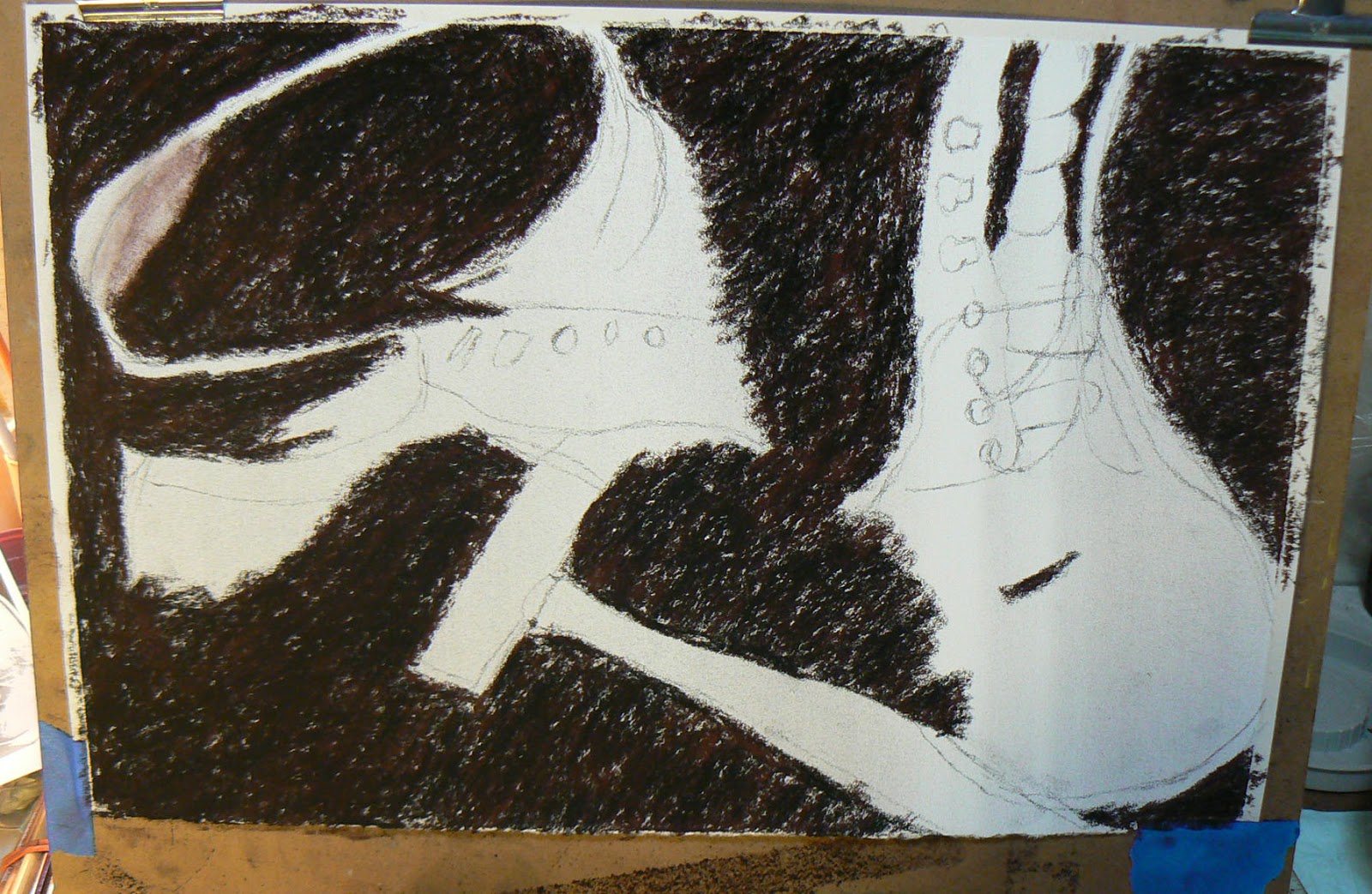 |
| Step Two |
|
|
|
|
Step two was to follow essentially the same path of the brown pastel, only this time I used a Black Prismacolor pastel stick. Why not use Black first? I believe the darker brown initially provides more depth to the black.
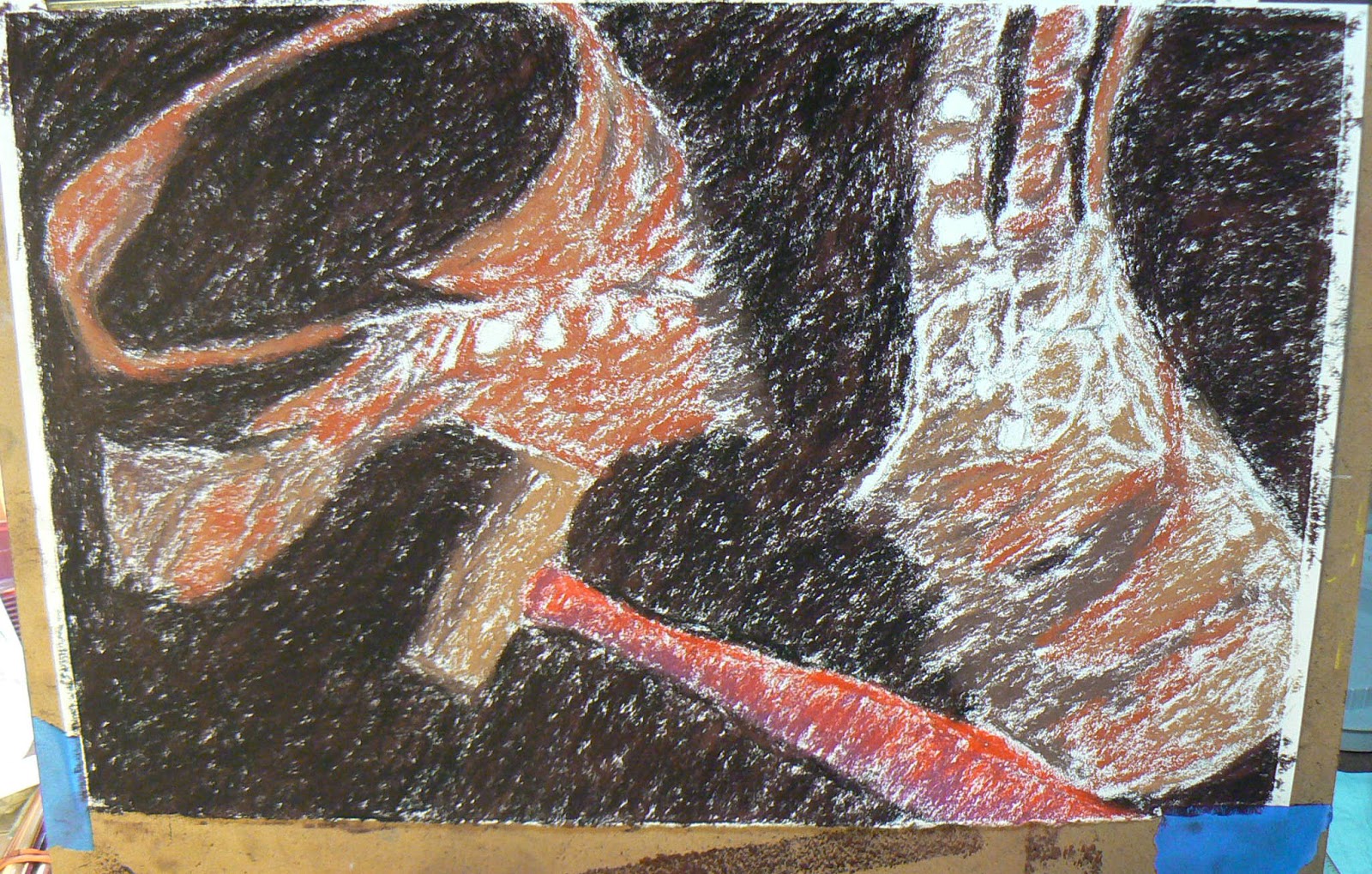 |
| Step Three |
In Stage Three, I begin to introduce more color. Again, all I am using at this point are Prismacolor pastel sticks. Colors at this stage included Burnt Sienna, Sepia, Light Umber, Yellow Ochre, Red and a magenta-purple (Maroon or Plum) on the handle of the hammer.
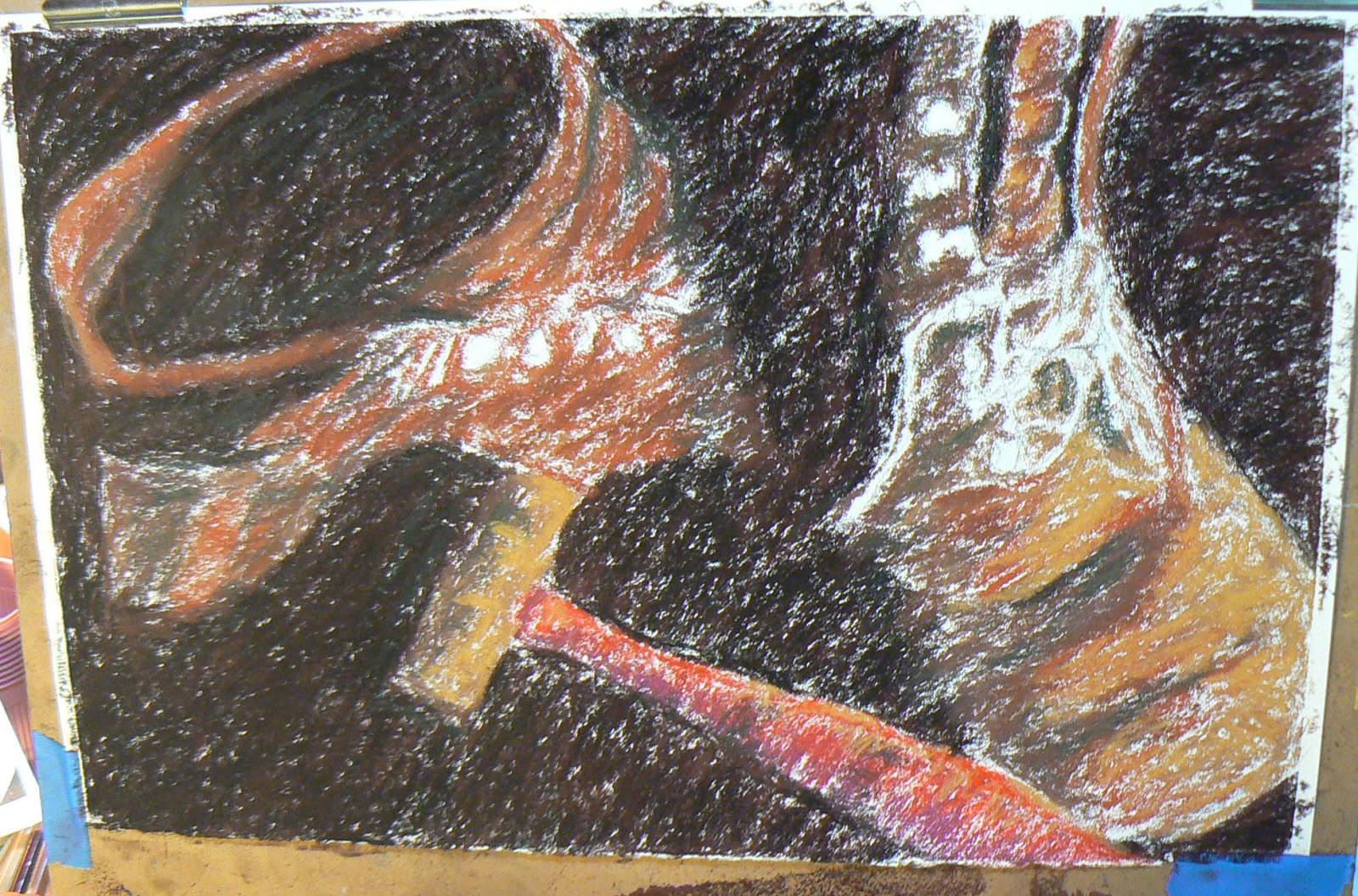 |
| Step Four |
More color is being added in Step Four, particularly with Yellow Ochre and an addition of Indian Red around the tongue of the boot on the right. As you can see, I've left colorless the areas where I intended to add the boot strings and the eyelets.
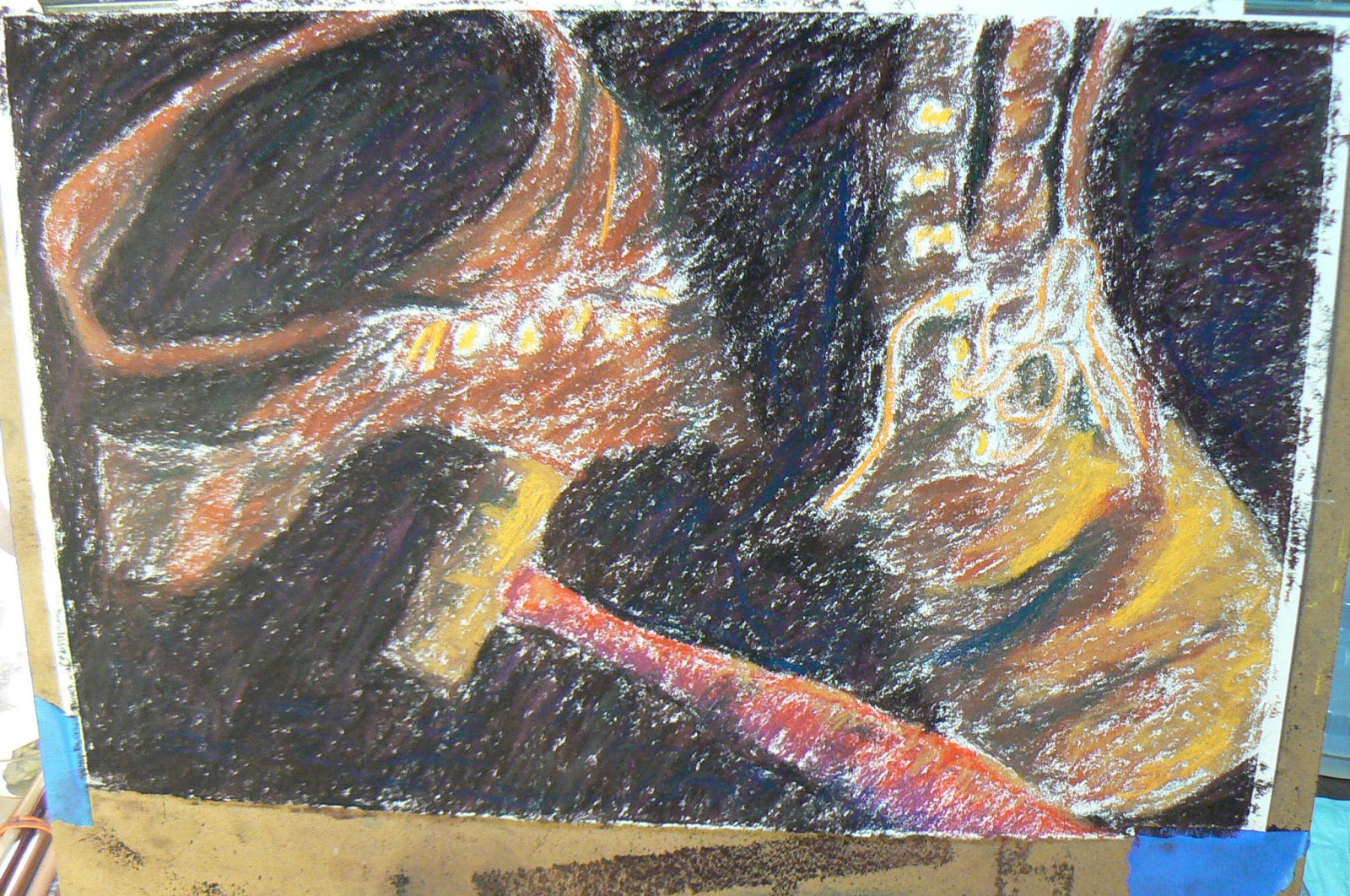 |
| Stage Five |
In this step, I've added Cadmium Yellow Deep in areas that I want to highlight. I've also introduced that same color to the eyelets. There are a couple streaks of Bottle Green in there too. I also added some Blue Violet in the backround to give the black more depth. I roughed in with Yellow Ochre a couple of the shoestrings, but I knew at this stage that where they are now is not necessarily where they will be at the end. Artists make adjustments. (Another future blog topic)
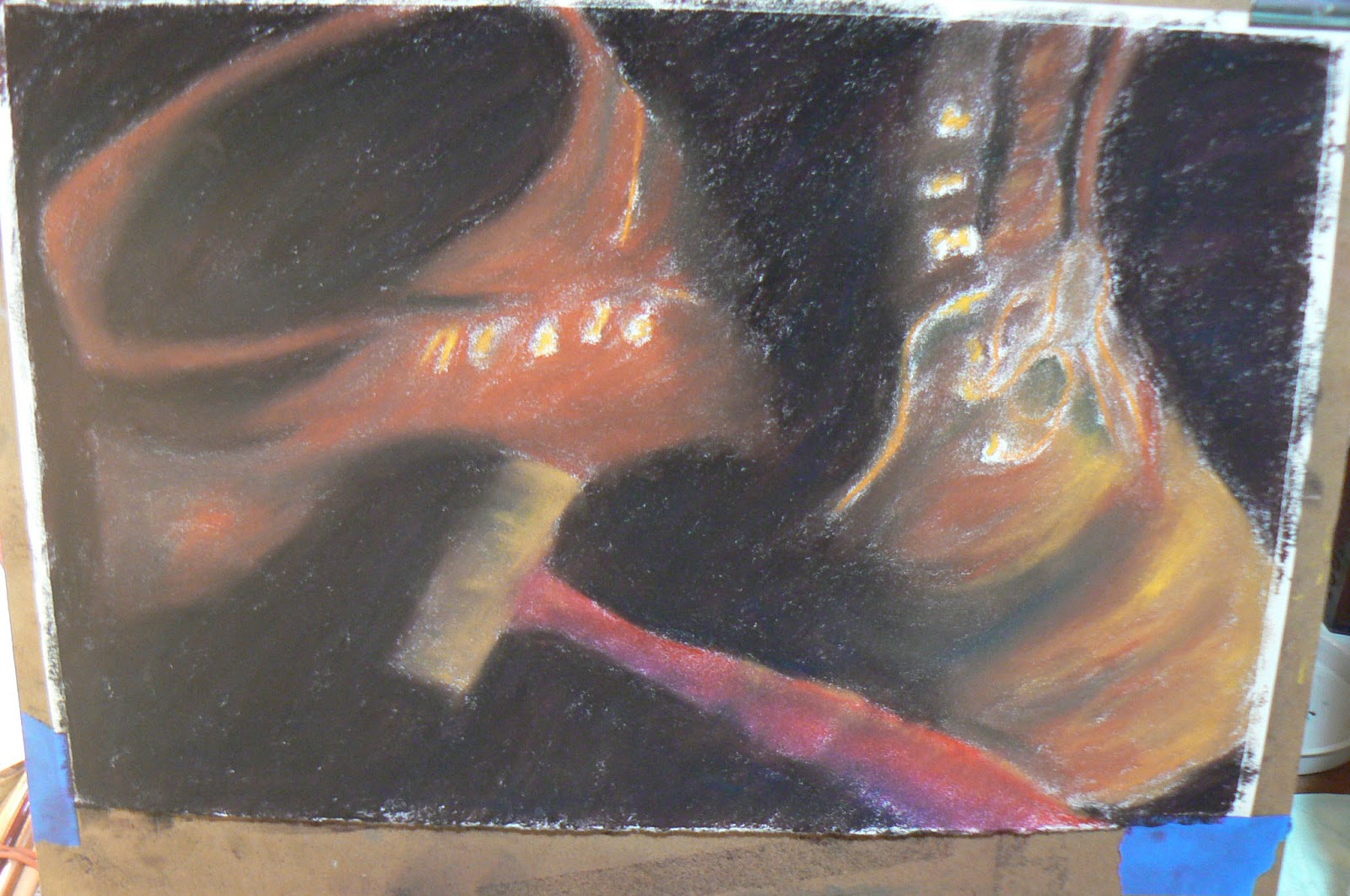 |
| Stage Six |
This is the fun part. Blending time. My favorite blending tools are my index fingers and my little fingers. I am indeed blending the entire painting as this point. This will be the only time that I will blend the entire painting. And, for the most part, there would be very little blending done with my fingers from here to the end. The rest of the blending that takes place is from the process of putting on more layers of pastel.
Blending, for me at least, is enjoyable. It's like being a kid again and finger painting. Only this time, you have a sanded surface under the layers of color.
The vitally important thing you have to remember throughout all of this -- and especially during the finger blending stage -- is to keep your fingers as clean from pigment as possible. So you blend one area first (I started with the dark area and probably won't do that again), then wipe off your hands thoroughly and then blend another area (rinse and repeat) and so forth until you have the blended painting where you want it.
Next week we finish the WIP and show the final painting.
Till then ... Keep Arting!
PS -- I have opened an Etsy Art Store! The link can be found on the Blog. You can also "Like" me on my new Facebook page at Mbpgrafix!












